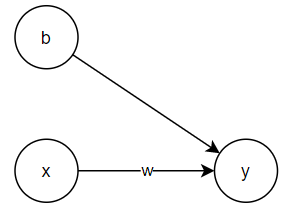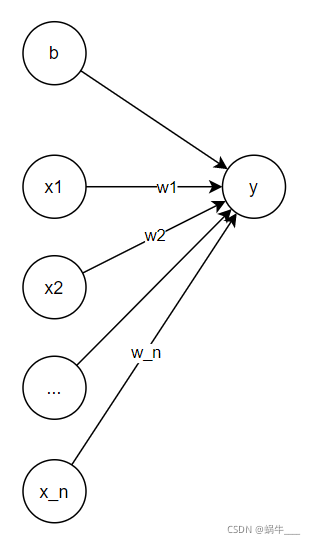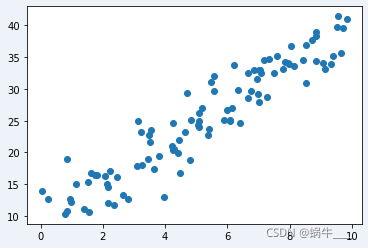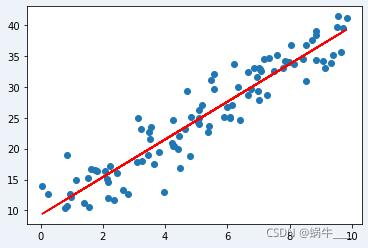PyTorch Beginner's Tutorial (1) - Implementing Linear Regression
Transforming Linear Regression into a Neural Network
Linear regression can also be viewed as a simple neural network. Consider a univariate linear regression model with one feature:
$$ \begin{aligned} y = w \cdot x + b \end{aligned} $$
This can be represented in the following neural network structure:

If we generalize $x$ into a vector, i.e., $x=(x_1, x_2, ... , x_n)$, the corresponding neural network structure becomes:

Implementing Univariate Linear Regression with PyTorch
Code Implementation for Univariate Linear Regression Using PyTorch
```python import torch import matplotlib.pyplot as plt ```
First, generate test data:
```python X = torch.rand(100, 1) * 10 # Generates 100 rows with one column, uniformly distributed in [0,10] X[:3] ```
```
tensor([[3.7992],
[5.5769],
[8.8396]])
```
```python y = 3 * X + 10 + torch.randn(100, 1) * 3 # Calculate corresponding y values; y is also 100 rows by 1 column y[:3] ```
```
tensor([[19.4206],
[29.7004],
[38.3561]])
```
Next, plot the data to visualize it:
```python plt.scatter(X.numpy(), y.numpy()) plt.show() ```

Now, define the linear regression model:
```python
class LinearRegression(torch.nn.Module):
"""
The model inherits `torch.nn.Module`, a required superclass for models in PyTorch.
"""
def __init__(self):
super().__init__() # Initialize the base class
"""
Define the first layer (linear layer) of the neural network. Important parameters:
in_features: Number of input neurons
out_features: Number of output neurons
bias: Whether to include a bias term
For more on torch.nn.Linear, refer to: https://pytorch.org/docs/stable/nn.html#linear-layers
"""
self.linear = torch.nn.Linear(in_features=1, out_features=1, bias=True)
def forward(self, x):
"""
Forward propagation to compute the network’s output
"""
predict = self.linear(x)
return predict
```
With this, the model is defined. Now, initialize the model:
```python model = LinearRegression() # Initialize model ```
Define the optimizer, choosing stochastic gradient descent:
```python
"""
torch.optim.SGD accepts key parameters:
- params: Model parameters
- lr: Learning rate
"""
optimizer = torch.optim.SGD(model.parameters(), lr=1e-3)
# View model parameters
for param in model.parameters(): # model.parameters returns an iterable object for multiple parameters
print(param)
```
``` Parameter containing: tensor([[-0.0462]], requires_grad=True) Parameter containing: tensor([-0.5942], requires_grad=True) ```
Define the loss function, here using MSE (mean squared error):
```python loss_function = torch.nn.MSELoss() ```
Now we can start training the model:
```python
for epoch in range(10000): # Train for 10,000 epochs
"""
1. Pass X through the model to compute predicted y values
X.shape and predict_y.shape are both (100,1)
"""
predict_y = model(X)
"""
2. Calculate loss using the loss function
"""
loss = loss_function(predict_y, y)
"""
3. Perform backpropagation
"""
loss.backward()
"""
4. Update weights
"""
optimizer.step()
"""
5.Clear the optimizer’s gradient to avoid interference in the next iteration
"""
optimizer.zero_grad()
```
Finally, view the final parameters to verify the result:
```python
for param in model.parameters(): # model.parameters returns an iterable object for multiple parameters
print(param)
```
``` Parameter containing: tensor([[3.0524]], requires_grad=True) Parameter containing: tensor([9.2819], requires_grad=True) ```
Let's plot the final result:
```python plt.scatter(X, y) plt.plot(X, model(X).detach().numpy(), color='red') plt.show() ```




